- Published 30 Jan 2023
- Last Modified 27 Nov 2023
- 13 min
Heat Sink Buying Guide
Discover more about heatsinks, including why they're important and how to choose the best heatsink for your setup.

This guide is designed to give you a better understanding of what heat sinks do, how they’re fitted, and why they work as effectively as they do. If you’re trying to work out the most suitable heat sink for your setup, the information below should give you a clearer idea of the best heat sink to buy.
What is a Heat Sink?
Heat sinks are a widely used method of cooling for parts or components that can become hot while in use. Many types of electronics and mechanical devices or machinery use heat sinks to help them dissipate the heat they generate.
So, what does a heat sink do? The simple answer is that it gradually transfers heat energy away from whatever component is generating it. More broadly, using a heat sink improves performance and extends the life of the component(s) in question, allowing them to run better, longer, and more efficiently.
Strictly speaking, the definition of a heat sink can include any substance or device that absorbs or dissipates heat - especially when the heat is unwanted or detrimental to performance. After all, in extreme cases, electrical or mechanical heat build-up could cause complete system failures, fires, explosions, or injury.
In practice, the term ‘heat sink’ typically refers to various kinds of electronics cooling, where it might also be referred to as a heat spreader, or simply a cooler. Coolers of this type are a form of radiator because they radiate the heat they collect out into the atmosphere and away from the source.
Heat sinks are used to absorb and dissipate the high temperatures created by many different sorts of electronic and mechanical devices. In fact, any system that generates heat as a by-product of normal running might make use of a heatsink-type device to help important parts stay cooler. Examples can include mechanical, fuelled, electronic, friction, chemical, solar, or nuclear processes.
There are various heat sink types in common use, and they can look quite different from one model to the next. However, most types do still have a number of key features or characteristics in common.
Different Types of Heat Sink
As mentioned above, there are several different types of heat sinks. However, they are almost always made from metal, most often copper or aluminium.
One of the most common designs for a heat sink is the familiar ‘fin’ layout. There are also alternative versions that use pins, stamping, and various other moulding techniques to increase both surface area and the overall rate of heat transfer.
The majority of heat sinks are passive. This means that they will naturally conduct heat away from the source without any further equipment or processes required, as long as they remain in direct contact with the particular part or component in question.
However, additional cooling measures (such as powered fans) can often be attached to a heatsink, making the dissipation much more effective. Products that employ such techniques are generally referred to as active heat sinks.
A helpful comparison between some of the more widely used heat sink types can be seen in the following sections.
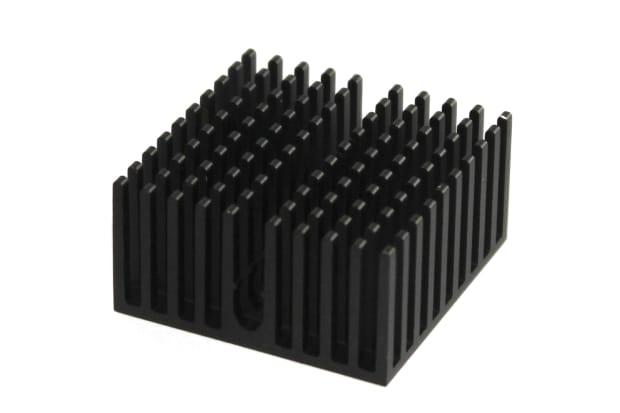
Passive Heat Sinks
As noted above, a passive heat sink is one that isn’t directly assisted by any additional products or processes while cooling a component. When you attach a passive cooling heatsink to an electrical or mechanical part, the heat being generated is dispersed entirely through the direct contact established between them and thus out into the surrounding air.
Because they’re expected to perform the task as a standalone solution (without the added benefit of fans or other cooling methods), passive heat sinks are often physically larger than many ‘active’ models. Combined with a typical finned or pin layout, this gives them the large surface area they need to transfer heat into the atmosphere and away from the part they’re helping to cool.
Products such as an aluminium passive cooling heat sink are most often used on lower power draw electronics or machinery that doesn’t get hot enough to make active cooling necessary. They’re also a cheaper thermal transfer solution where very large components make active cooling impractical. They generally require a decent amount of clearance room around the part they’re being attached to.

Active Heat Sinks
An active heat sink is one that uses fans, water pumps, or some other powered process to enhance cooling capacity and speed up the rate of heat transfer. In computers and other electronic systems, these sorts of coolers typically run off the PC’s internal power supply.
The most common form of active cooling heatsink involves one or more fans being mounted directly above or on the side of the heat fin stack. These fans then push/pull a constant flow of fresh air across the metal cooler, making thermal dissipation much more effective. You’ll sometimes see a heat sink with an integrated fan referred to as an HSF.
More advanced types of active heatsink might use water or other liquids to help carry heat away from a source. The simplest form of liquid cooling is called a closed-loop cooler, or CLC.
In a CLC setup, a pump continually pulls a fixed volume of water/coolant around a sealed and enclosed network of tubes. The liquid flows through a block attached directly to the component being cooled, where it absorbs heat through a contact plate. It’s then channelled to a radiator or heatsink, where a secondary thermal transfer takes place between the water and the surrounding air. In this way, the liquid is cooled before looping back around again, and so on.
Whether powered by fans or pumps, active cooling heat sinks are widely used as a temperature control system in electronics, protecting and enhancing the performance of various chips, LEDs, ICs and other modules. They are especially important in computers, as CPUs and graphics cards, in particular, will often get very warm under load.
Insufficient cooling can have a drastic impact on electrical performance, either through physical damage to circuits or due to a process known as ‘thermal throttling’. The latter occurs when a PC or other ‘smart’ system detects rising temperatures and attempts to limit heat build-up by aggressively restricting the power available to key components.
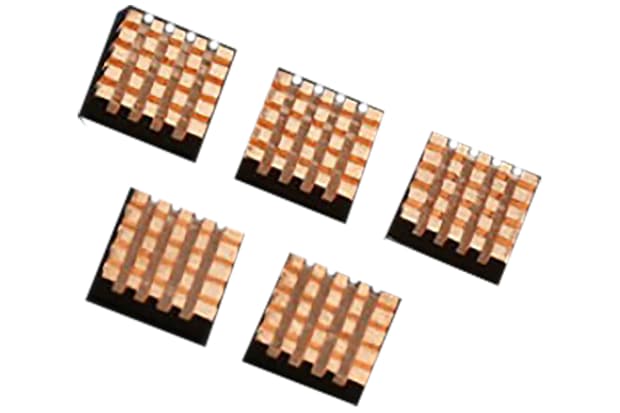
Copper Heat Sinks
Copper is frequently used as the core material for a wide range of heat sink designs, due to its impressive heat transfer qualities. It’s an excellent thermal conductor, helping to draw heat quickly and efficiently away from the device or circuit you’re trying to cool. On the downside, copper heatsinks are typically more expensive (and up to three times heavier) than popular alternatives, such as aluminium.
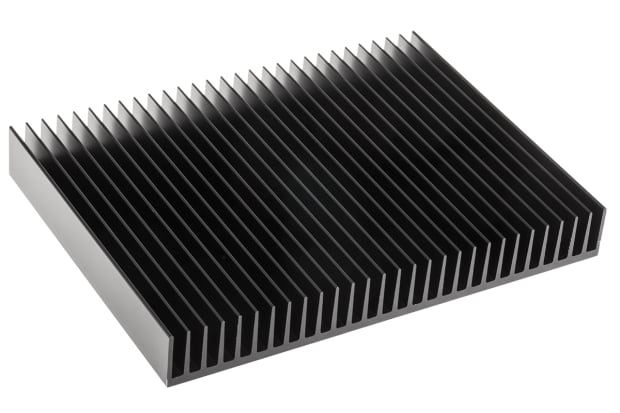
Aluminium Heat Sinks
Although aluminium doesn’t conduct heat as efficiently as copper, it's considerably lighter and less expensive. It can also be a more structurally robust metal when used in thin sheets (extruded aluminium), as is the case in most copper and aluminium heat sink constructions. Many aluminium heat sinks feature a design in which the heat is allowed to rise through a number of thin metal fins – explained in greater detail in the section below.
Some types of heat sinks, such as bonded fin versions, can be made of both copper and aluminium. It’s not uncommon to find one metal used for the base or contact plate (often copper), and the other for the fins.
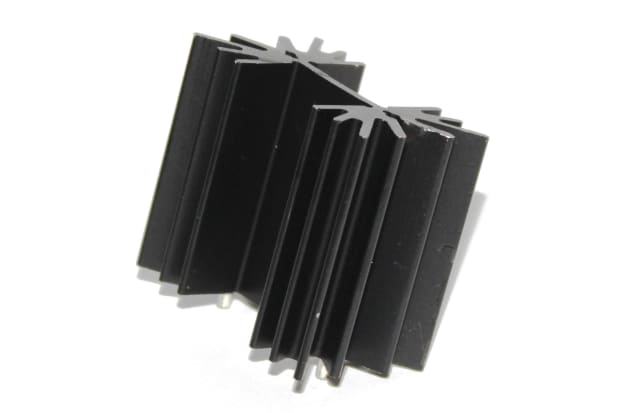
Finned Heat Sinks
A finned heat sink is made from a solid block of metal which has been feathered or sliced into a large number of very thin plates, extending away from the central block. This design gives the heatsink with fins a much greater surface area. It makes for a far more efficient and effective transfer of heat away from any component the cooler is attached to.
When designing and manufacturing a heat sink fin, there are several potential processes that can be used. Nowadays, the most common is probably either forged or die-cast models, or CNC machining or milling. Die-cast fin heat sinks are more common for cheaper, high-volume sales, while a CNC milled fin heat sink typically results in a more expensive but superior quality product that tends to ship in lower volume.
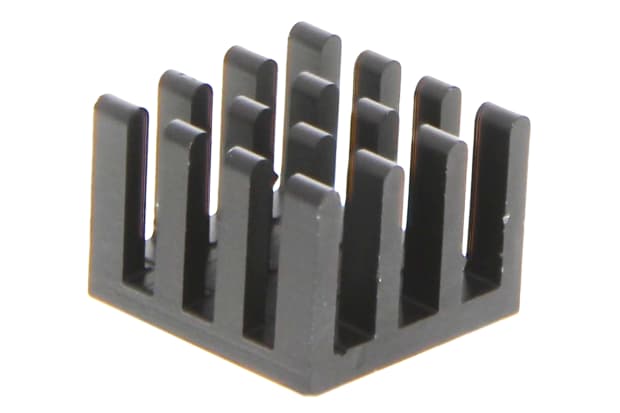
Pinned Heat Sinks
A heatsink with pins can either be called simply a pin heat sink, or a pin fin cooler. In real terms, it’s simply an alternative design to the much more commonplace flat fin design outlined above. In the pinned configuration, the core block is constructed with a cluster of pins or rods extending upward or outward from its base. The pins themselves can be cylindrical, elliptical or square.
Pinned heat sinks are often calculated to have a greater overall surface area than finned varieties. However, they won’t necessarily give you a significant performance improvement in many day-to-day applications, and they’re generally less widely used than fin models.
Heat Sink Manufacturing Types
As noted above, there is a wide variety of constructions, designs and manufacturing techniques used in making heatsinks for computers, motherboards and other devices. Common options include:
- Extruded heat sinks - the metal is simply forced into the required shape; extremely common in a wide range of applications
- Forged heat sinks - relies on a die or mould to set the metal in the form needed; often cheaper for mass production
- Bonded heat sinks - fins are individually attached to the base in a dense array, ideal for bespoke or space-limited applications
- Stamped heat sinks - among the cheapest to mass-produce, but generally less powerful and effective as coolers
- CNC machined heat sinks - often among the more expensive options as the metal is precision-cut from a solid block, meaning much more material goes to waste
- Skived or zipper fin heat sinks - a highly effective (and, again, typically more expensive) manufacturing process, using a dedicated machine to cut the fins and then push them up into position; identified by a slight curve at the fin base
Most of these techniques offer alternate ways of achieving the classic finned or pinned heatsink layout. Typically, the choice will come down to striking the best balance for an individual supplier between quality, performance, cost, and sales volume.
What Can Heat Sinks Be Used for?
We’ve already touched on the importance of heatsinks for cooling vital PC components such as CPUs and GPUs. Some other examples of everyday heat sink uses include:
- Motherboard heatsinks
- Solid-state and relay heat sinks
- Power transistor heat sink
- PCB heat sinks
- External/internal laptop heatsinks
- Heat sinks for amplifiers
How to Choose the Right Heat Sink
When asking yourself ‘What type of heat sink should I buy?’, the answer will almost always come down to the specifics of your setup and cooling needs. Identifying some basic details about your intended application is the first step in knowing how to choose heat sinks.
Key considerations for the best choice of heat sink include:
- What sort of power draw the component in question will be using.This is often referred to as the TDP (thermal design power, or thermal design profile).TDP is often used as a basic indication of a component’s power consumption, especially with CPUs (processors) and GPUs (video cards). TDP ratings specify the maximum heat a component can use in watts.It’s typically a good indicator of how hot a particular part has the potential to get under load
- How cool the component ideally needs to be kept in order to perform optimally
- How much space is available to install a cooler, heat spreader, or heat sink - they’re available in a wide variety of sizes, from tiny module heat sinks to much larger installations
- Which type of heat sink design or layout will give you the best thermal performance for your system specs
- Whether you need an active heat sink or a passive radiator
- How much you’re willing to spend on a cooler
Heat Sinks by Brand
There are many trusted heat sink manufacturers. Some specialise in electronics and PC radiator models, while others are more commonly associated with industrial design and machine cooling.
The content below explores some of the popular heatsink brands, their applications and benefits.
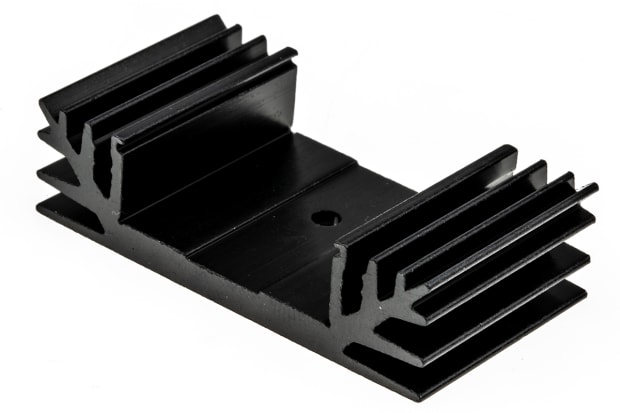
Aavid heat sinks
Main Benefits :
- Comprehensive range of heat sinks
- Experts in a wide range of cooling solutions
Application :
- Perfect for a wide range of applications

Fischer heat sinks
Main Benefits :
- Experts in smaller heat sinks
- Extensive range available
Application :
- Many versions perfect for IC processors

RS Pro heat sinks
Main Benefits :
- Trusted brand
- Conforms to all the latest standards
Application :
- Ideal for a wide range of applications

Malico heat sinks
Main Benefits :
- High-quality product finishes
- Heat sinks designed to suit a range of performance levels
Application :
- Offer a range of heat sinks for different applications
Typical Applications of a Heat Sink
You can find some typical applications of the various types of heat sinks in the table below.
Type | Material | Applications |
|---|---|---|
Passive | Copper | AC/DC Converter |
Active | Aluminium | IC Cooling |
Passive | Aluminium | LED |
FAQs
How Do You Fit a Heat Sink?
Almost every individual type, make and model of heatsink has its own particular mounting mechanism, although the majority will look reasonably similar from one product to the next.
In most cases, the installer will need to attach the base plate of the cooler tightly to the surface of the component they’re cooling. This is usually done via a manual clamping or screw-down assembly. There’s a broad array of heatsink mounting accessories available for various models, including spring clips, spring mount rivets, screws, and adhesive tapes.
Nearly all heat sinks, especially those intended for use in computers and motherboards, will require an application of thermal paste between the component and the heat plate of the cooler.
Thermal paste (also called TIM or thermal grease) is a heat-conducting substance that improves thermal transfer between two metal plates. It helps to fill in any small gaps left by tiny imperfections in either surface, resulting in far better overall cooling performance. Over time it can dry and crack, requiring periodic reapplication.
Why are Heat Sinks Used in Power Amplifiers?
As with many other types of electrical equipment, the active elements in a power amplifier - specifically the transistors - can generate a surprising amount of heat as they conduct current. Just like PC components, these parts have an operational temperature limit that can’t be exceeded without risk of damage, failure, or (at the very least) severely impeded performance.
Buying a good heatsink suitable for the job helps to protect delicate electronics and the people using them while ensuring you get the best results from your devices.
Does Raspberry Pi Need a Heatsink?
Not typically, no - provided you’re using your Raspberry Pi set up within the limits it was designed for. While certain updated models are seen as using slightly increased power draw, the majority of chips used in RasPi builds (such as BCM2835) were created to function reasonably without one.
That said, additional cooling never hurts with 99% of electronics, and you may see improved performance by lowering temperatures on almost any enclosed system. There are commands you can run to check the operating temperature of a Raspberry Pi while under load.
Can I Change a Heat Sink Myself?
In most cases, yes - it’s certainly fairly common practice in computer maintenance. Provided you’ve carefully read and understood the instructions and steps required to install a given model of computer heat sink or cooler, you should have little difficulty in mounting the heatsink to the desired component.
If you’re unsure about how to change a heatsink or uncertain if you even need to do so, it’s always best to talk to an expert for professional help and advice.


